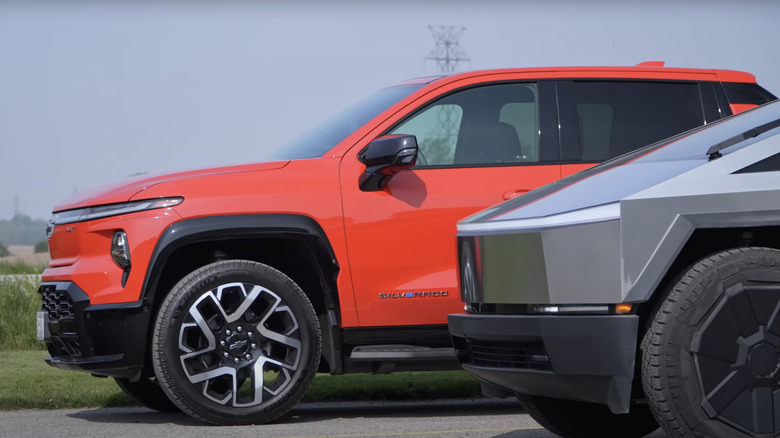Charging A Tesla Cybertruck Vs Gassing Up A Chevy Silverado: Which Is More Expensive Monthly?
Compared to internal combustion engine cars, EVs promise efficiency, cleaner energy, and cheaper running costs. In theory, driving something like a Tesla Cybertruck over a Chevrolet Silverado should save you money on fuel costs. However, in the real world, things can get interesting. So, which is more expensive monthly?
According to estimated ownership data, the Chevrolet Silverado 1500 averages 17 mpg. If we were to drive it 1,500 miles within a month with the current average U.S. gasoline price of $3.10 per gallon, it would end up costing about $274. On the other hand, tests show that the Tesla Cybertruck uses around 0.399 kWh per mile of electricity, while Tesla's own estimates place that number closer to 0.429 kWh per mile for the AWD model.
If we consider the average U.S. residential electricity price of 17.47 cents per kWh and assume the same 1,500 miles, the Cybertruck would cost between $105 and $112 per month to charge at home. However, if one were to only rely on the Tesla Supercharger network, the total could easily creep up to $300 for 1,500 miles. This means that, even though the true costs of owning an electric vehicle can be less expensive if you use available incentives and charge at home, in the end, it all boils down to how you use it.
Electricity isn't always cheaper
There are simply too many variables to make an apples-to-apples comparison, and in some instances, a Chevrolet Silverado can even be cheaper. Right out the gate, you pay more for a Cybertruck; the Cybertruck starts at $72,235, which is twice the price of an entry-level Silverado. Even with the lowest charging costs, the price difference could easily take more than ten years of driving to recoup.
Trucks are also utility vehicles used by many for work, with hauling and towing being a large part of that work. In a test carried out by MotorTrend, a Cybertruck was tasked with towing a 3,170-pound trailer, and that was enough to cut its range to just 160 miles from the official 318-mile range. Moreover, a test carried out by InsideEVs has actually shown that the Ram 2500 was 30% cheaper than a Cybertruck while towing 8,000 pounds. Additionally, the Cybertruck lost most of its usable battery charge after only 85 miles of driving. EVs lose range during the winter, which can further dial up the costs and make the comparison even harder to quantify.
Regional differences also need to be mentioned since cheaper fuel prices can further sway the comparison. For example, gas prices in Oklahoma currently hover around $2.60 per gallon, which means that a 24-gallon Silverado tank costs $62 to fill, which is considerably lower than what many Cybertruck owners pay at a Supercharger for a full charge.
How to save money on electric car ownership
When talking about EV ownership costs, the International Energy Agency's Global EV Outlook 2025 states that the total costs of owning an electric vehicle vary with usage profiles, energy prices, the MSRP, and regional factors. Therefore, many ways exist to make owning an EV cheaper. Even though EV incentives aren't as generous as they once were, there are still states that do offer EV tax credits and rebates.
Home charging can lower your overall running costs, but there are many factors EV owners need to know before installing a home charger. Moreover, off-peak electricity hours are also important since electricity tends to be cheaper in the evening, while afternoon rates are the highest. If you are unable to charge at home and must use the public charging infrastructure, use apps to compare prices or get discounts.
It's important to avoid idle fees by unplugging right after charging, and to stick to AC chargers, which tend to be more affordable. There is money to be saved on your driving habits as well. Driving smoothly with regenerative braking can make a difference. Maintain tire pressure, avoid aggressive accelerations, and keep your battery maintained to make the most of it.


